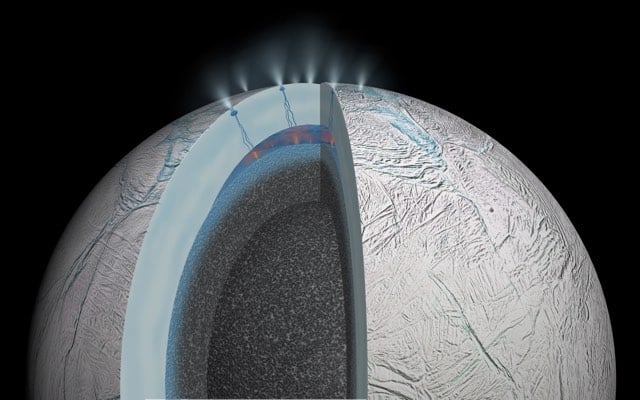Hydrothermal hints of the potential for life on Enceladus

Two teams of NASA scientists have discovered evidence that hydrothermal vents on the Saturnian moon of Enceladus show signs of “active hot-water chemistry”. Why is that exciting? Because similar chemistry occurs deep in the Earth’s oceans *and* can support life. Phil Plait explains.
We see these vents in the ocean bottom on Earth, too. The water there is very hot, heated by tectonic processes inside Earth’s crust. It brings up minerals and nutrients, and life thrives there. A lot of the processes are the same as what’s imagined is happening on Enceladus; minerals are dissolved in hot water that spews up into the cold ocean, precipitating out. A lot of it is sulfur based, but amazingly life exists there anyway. The environment is highly toxic to humans-huge pressure, boiling water near the vents, freezing a bit farther away, and loaded with icky chemicals-but as a scientist once said, “Life finds a way.”
Between the evidence of past flowing water on Mars, Titan’s hydrocarbon lakes, Europa’s underground ocean, and Enceladus, it seems increasingly probable we’ll find life somewhere else in the solar system. That’s a pretty exciting prospect! (via @ericholthaus)
Update: It was also announced today that the Hubble has detected signs of a salty underground ocean on Jupiter’s moon Ganymede.
New observations of the moon using Hubble support this. Ganymede has a weak magnetic field, and, like on Earth, this generates an aurora-the glow created when high-speed subatomic particles slam into the extremely thin atmosphere. This glow is brightest in ultraviolet, and so astronomers used the Space Telescope Imaging Spectrograph (my old camera!) on Hubble to observe Ganymede. STIS is quite sensitive to UV and detected the aurora.
Now this part is a bit tricky: Jupiter has a powerful magnetic field as well, which interacts with Ganymede’s. As they do, the aurora changes position over time, moving up and down in latitude. However, the observations show that the aurorae do not change nearly as much as expected if Ganymede were solid. The best way to explain this is if the moon has a salty ocean under its surface. The ocean would have its own magnetic field and would resist the influence of Jupiter’s magnetic field, which in turn keeps the aurora steadier.
Turns out there’s water all over the place in the solar system. How about that?





Stay Connected